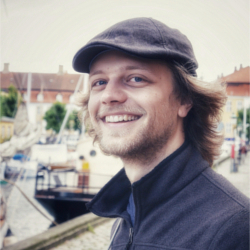Quantifying the Quality of Haptic Interfaces
Shape-Changing Haptic Interfaces
Generating Clear Vibrotactile Cues with Magnets Embedded in a Soft Finger Sheath
Salient Full-Fingertip Haptic Feedback Enabled by Wearable Electrohydraulic Actuation
Cutaneous Electrohydraulic (CUTE) Wearable Devices for Pleasant Broad-Bandwidth Haptic Cues
Modeling Finger-Touchscreen Contact during Electrovibration
Perception of Ultrasonic Friction Pulses
Vibrotactile Playback for Teaching Sensorimotor Skills in Medical Procedures
CAPT Motor: A Two-Phase Ironless Motor Structure
4D Intraoperative Surgical Perception: Anatomical Shape Reconstruction from Multiple Viewpoints
Visual-Inertial Force Estimation in Robotic Surgery
Enhancing Robotic Surgical Training
AiroTouch: Naturalistic Vibrotactile Feedback for Large-Scale Telerobotic Assembly
Optimization-Based Whole-Arm Teleoperation for Natural Human-Robot Interaction
Finger-Surface Contact Mechanics in Diverse Moisture Conditions
Computational Modeling of Finger-Surface Contact
Perceptual Integration of Contact Force Components During Tactile Stimulation
Dynamic Models and Wearable Tactile Devices for the Fingertips
Novel Designs and Rendering Algorithms for Fingertip Haptic Devices
Dimensional Reduction from 3D to 1D for Realistic Vibration Rendering
Prendo: Analyzing Human Grasping Strategies for Visually Occluded Objects
Learning Upper-Limb Exercises from Demonstrations
Minimally Invasive Surgical Training with Multimodal Feedback and Automatic Skill Evaluation
Efficient Large-Area Tactile Sensing for Robot Skin
Haptic Feedback and Autonomous Reflexes for Upper-limb Prostheses
Gait Retraining
Modeling Hand Deformations During Contact
Intraoperative AR Assistance for Robot-Assisted Minimally Invasive Surgery
Immersive VR for Phantom Limb Pain
Visual and Haptic Perception of Real Surfaces
Haptipedia
Gait Propulsion Trainer
TouchTable: A Musical Interface with Haptic Feedback for DJs
Exercise Games with Baxter
Intuitive Social-Physical Robots for Exercise
How Should Robots Hug?
Hierarchical Structure for Learning from Demonstration
Fabrication of HuggieBot 2.0: A More Huggable Robot
Learning Haptic Adjectives from Tactile Data
Feeling With Your Eyes: Visual-Haptic Surface Interaction
S-BAN
General Tactile Sensor Model
Insight: a Haptic Sensor Powered by Vision and Machine Learning
Causal Representation Learning

Causal representation learning aims to move from statistical representations towards learning causal world models that support notions of intervention and planning, see Fig. (a) [].
Coarse-grained causal models Defining objects that are related by causal models typically amounts to appropriate coarse-graining of more detailed models of the world (e.g., physical models). Subject to appropriate conditions, causal models can arise, e.g., from coarse-graining of microscopic structural equation models [], ordinary differential equations [
], temporally aggregated time series [
], or temporal abstractions of recurrent dynamical models [
]. Although models in economics, medicine, or psychology typically involve variables that are abstractions of more elementary concepts, it is unclear when such coarse-grained variables admit causal models with well-defined interventions; [
] provides some sufficient conditions.
Disentanglement A special case of causal representation learning is disentanglement, or nonlinear ICA, where the latent variables are assumed to be statistically independent. Through theoretical and large-scale empirical study, we have shown that disentanglement is not possible in a purely unsupervised setting [] (ICML'19 best paper). Follow-up works considered a semi-supervised setting [
], and showed that disentanglement methods learn dependent latents when trained on correlated data [
].
Multi-view learning Learning with multiple views of the data allows for overcoming the impossibility of purely-unsupervised representation learning, as demonstrated through identifiability results for multi-view nonlinear ICA [] and weakly-supervised disentanglement [
]. This idea also helps explain the impressive empirical success of self-supervised learning with data augmentations: we prove that the latter isolates the invariant part of the representation that is shared across views under arbitrary latent dependence, see Fig. (b) [
].
Learning independent mechanisms For image recognition, we showed (by competitive training of expert modules) that independent mechanisms can transfer information across different datasets []. In an extension to dynamic systems, learning sparsely communicating, recurrent independent mechanisms (RIMs) led to improved generalization and strong performance on RL tasks [
]. Similar ideas have been useful for learning object-centric representations and causal generative scene models [
].
Extracting causal structure from deep generative models We have devised methods for analysing deep generative models through a causal lens, e.g., for better extrapolation [] or creating hybridized counterfactual images, see Fig. (c) [
]. Causal ideas have also led to a new structured decoder architecture [] and new forms of gradient combination to avoid learning spurious correlations [
].
New notions of non-statistical independence To use the principle of independent causal mechanisms as a learning signal, we have proposed two new notions of non-statistical independence: a general group-invariance framework that unifies several previous approaches [], and an orthogonality condition between partial derivatives tailored specifically for unsupervised representation learning, see Fig. (d) [
].
Members
Publications













